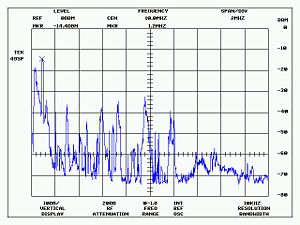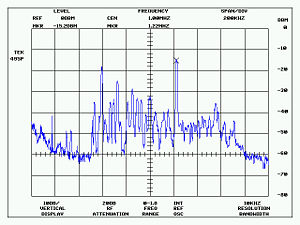Difference between revisions of "Antenna Performance Tests"
| Line 1: | Line 1: | ||
| − | |||
| − | |||
== Active Antenna and Mercury == | == Active Antenna and Mercury == | ||
| Line 33: | Line 31: | ||
This scan shows the AM broadcast band (centred at 1.0 Mhz, 200 Khz. per horizontal division) showing the strongest signals received at my QTH in the 0-30 Mhz spectrum. The strongest AM station is at 1220 Khz and is at -15 dbm at this snapshot. There is another strong station at 610 Khz and is approximately -19 dbm. [[Image:activeantennaplot2.jpg|thumb|300px| Active antenna spectrum 0-2 Mhz.]] | This scan shows the AM broadcast band (centred at 1.0 Mhz, 200 Khz. per horizontal division) showing the strongest signals received at my QTH in the 0-30 Mhz spectrum. The strongest AM station is at 1220 Khz and is at -15 dbm at this snapshot. There is another strong station at 610 Khz and is approximately -19 dbm. [[Image:activeantennaplot2.jpg|thumb|300px| Active antenna spectrum 0-2 Mhz.]] | ||
| − | |||
| − | |||
| − | |||
| − | |||
| − | |||
by Rick VE3MM | by Rick VE3MM | ||
Revision as of 08:12, 9 April 2010
Active Antenna and Mercury
One of the great features of Mercury is its wide band capability. Most amateurs have antennas that are tuned to one amateur band. Often, these antennas do not perform well when used to listen on other frequencies. One type of antenna that is suited to wide band performance is an active antenna.
I purchased a Z1501D Active Antenna and Z1203A Active Antenna Coupler from Clifton Laboratories [1]. These are both kits that are straightforward to put together and in my opinion are first class.
The active antenna at my station is using a 60 inch whip and the unit is mounted on a wooden fence post approximately 1.25 m above ground. I have a ground plate (1.2m long piece of electrical bus) buried in the earth about 0.6 m below ground.
Tests
The following is a screen shot of a wide band scan (0-20 Mhz.) of the output of the antenna coupler when connected to a Tektronics 495P Spectrum Analyzer.
by Rick VE3MM

